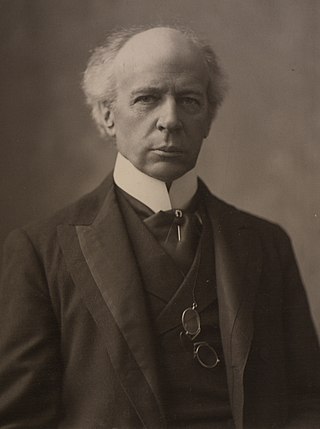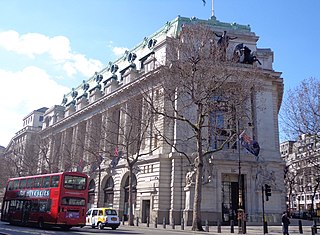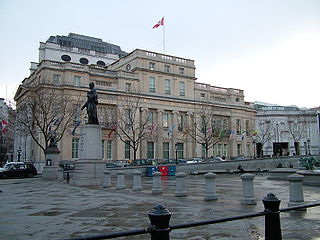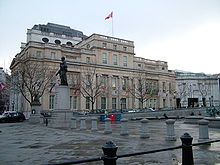
Alexander Mackenzie was a Canadian politician who served as the second prime minister of Canada, in office from 1873 to 1878.

Sir Charles Tupper, 1st Baronet,, M.D. was a Canadian Father of Confederation who served as the sixth prime minister of Canada from May 1 to July 8, 1896. As the premier of Nova Scotia from 1864 to 1867, he led Nova Scotia into Confederation. He briefly served as the Canadian prime minister, from seven days after parliament had been dissolved, until he resigned on July 8, 1896, following his party's loss in the 1896 Canadian federal election. He is the only medical doctor to have ever held the office of prime minister of Canada and his 68-day tenure as prime minister is the shortest in Canadian history.

Sir John Alexander Macdonald was the first prime minister of Canada, serving from 1867 to 1873 and from 1878 to 1891. He was the dominant figure of Canadian Confederation, and had a political career that spanned almost half a century.

The Pacific Scandal was a political scandal in Canada involving large sums of money being paid by private interests to the Conservative government to cover election expenses in the 1872 Canadian federal election, to influence the bidding for a national rail contract. As part of British Columbia's 1871 agreement to join the Canadian Confederation, the federal government had agreed to build a transcontinental railway linking the seaboard of British Columbia to the eastern provinces.

Sir Henri Charles Wilfrid Laurier, was a Canadian lawyer, statesman, and politician who served as the seventh prime minister of Canada from 1896 to 1911. The first French Canadian prime minister, his 15-year tenure remains the longest unbroken term of office among Canadian prime ministers and his nearly 45 years of service in the House of Commons is a record for the House. Laurier is best known for his compromises between English and French Canada.

Sir John Joseph Caldwell Abbott was a Canadian lawyer and politician who served as the third prime minister of Canada from 1891 to 1892. He held office as the leader of the Conservative Party.

Charles Vincent Massey was a Canadian diplomat who served as Governor General of Canada, the 18th since Confederation. Massey was the first governor general of Canada who was born in Canada after Confederation.

Events from the year 1874 in Canada.

Events from the year 1875 in Canada.

The 1874 Canadian federal election was held on January 22, 1874, to elect members of the House of Commons of Canada of the 3rd Parliament of Canada. Sir John A. Macdonald, who had recently been forced out of office as prime minister, and his Conservatives were defeated by the Liberal Party under their new leader Prime Minister Alexander Mackenzie.

Sir John Rose, 1st Baronet was a Scots-Quebecer politician. He was a member of the Legislative Assembly of the Province of Canada and the Executive Council of the Province of Canada. After Confederation, he held the offices of Solicitor General of Canada, Minister of Public Works and Minister of Finance in the new federal government. In the United Kingdom, he held the offices of Receiver General of the Duchy of Cornwall and Privy Counsellor.

Grosvenor Square is a large garden square in the Mayfair district of Westminster, Greater London. It is the centrepiece of the Mayfair property of the Duke of Westminster, and takes its name from the duke's surname "Grosvenor". It was developed for fashionable residences in the 18th century. In the 20th it had an American and Canadian diplomatic presence, and currently is mixed use, commercial.

The High Commission of South Africa in London is the diplomatic mission from South Africa to the United Kingdom. It is located at South Africa House, a building on Trafalgar Square, London. As well as containing the offices of the High Commissioner, the building also hosts the South African consulate. It has been a Grade II* listed building since 1982.

The High Commission of Australia in London is the diplomatic mission of Australia in the United Kingdom. It is located in Australia House, a Grade II listed building. It was Australia's first diplomatic mission and is the longest continuously occupied diplomatic mission in the United Kingdom.

Canada House is a Greek Revival building on Trafalgar Square in London. It has been a Grade II* Listed Building since 1970. It has served as the offices of the High Commission of Canada in the United Kingdom since 1925.
In the Commonwealth of Nations, a high commissioner is the senior diplomat, generally ranking as an ambassador, in charge of the diplomatic mission of one Commonwealth government to another. Instead of an embassy, the diplomatic mission is generally called a high commission.

The bilateral relations between Canada and the United Kingdom have yielded intimate and frequently-co-operative contact since Canada gained independence in 1931. Canada was previously self-governing since 1 July 1867, the date that became Canada's independence day.

Macdonald House was a seven-storey Neo-Georgian style building on Grosvenor Square in Mayfair, London. It was part of the High Commission of Canada from 1961 to 2014. Macdonald House was used for the High Commission's cultural and consular functions, trade and administrative sections, immigration section, and as the High Commissioner's official residence. From 1938 to 1960, the building was the Embassy of the United States.

The High Commission of India in London is the diplomatic mission of India in the United Kingdom. It is located in India House on Aldwych, between Bush House, what was Marconi House and Australia House. It faces both the London School of Economics and King's College London. Since 1981, India House is a Grade II listed building.





















